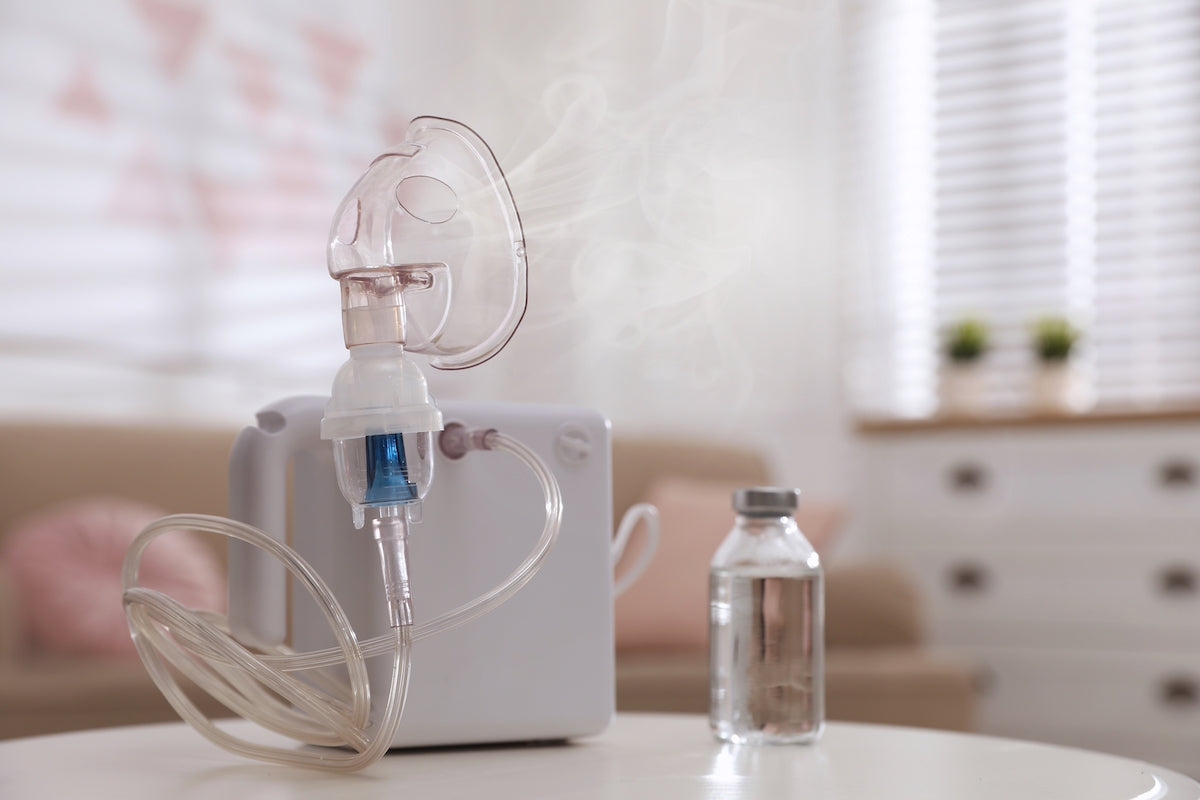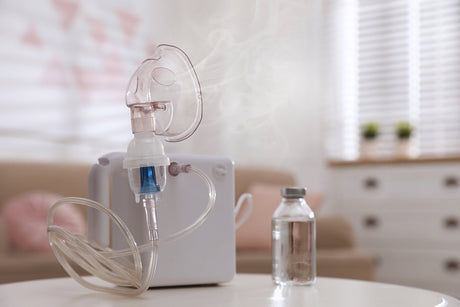When you're suffering from respiratory health disorders, some of the symptoms can be quick onset and highly interruptive, even despite ongoing treatment. Nebulizers provide a quick and effective solution for patients suffering from respiratory illnesses to get relief from their symptoms and restore their health and well-being.
Using a nebulizer to inhale prescription medicine straight into your system instantly.
Nebulizers are a great treatment choice for the following respiratory health conditions: Asthma, seasonal allergies, chronic obstructive pulmonary disease (COPD), and bronchitis. Ultrasonic nebulizers initially made an appearance in the United States in the form of humidifiers in 1949, but physicians were quick to add medications that turned them into therapeutic aerosols.
The nebulization story stretches as far back as about 150 years, and this life-enhancing treatment continues to evolve with medical advancements today. This in-depth guide covers everything you need to know about a home nebulizer, including how to use a nebulizer machine, different types, treatment, maintenance, pros & cons, and more.
What Is A Nebulizer?
A nebulizer is a mechanism that allows you to inhale medication as a fine mist through a mask or a mouthpiece. A nebulizer is made up of four parts:
- Chamber: Small plastic container
- Machine: An air compressor
- A length of air tubing
- Facemask or mouthpiece
Types Of Nebulizers
Nebulizers are classified into three categories:
- Jet: Compressed gas is used to create an aerosol
- Ultrasonic: This produces an aerosol using high-frequency vibrations. The particles are bigger than those produced by a jet nebulizer.
- Mesh: The aerosol is created by passing liquid through a very small mesh. The smallest particles are emitted.
Consult your physician to determine if a mouthpiece or mask is appropriate for you or a family member. NB: Face masks that fit over the nose and mouth are frequently preferable for children under the age of five.
How To Use A Nebulizer
To get your complete medicine dosage, you need to check that you’re following the steps correctly. The good news is that nebulizers are simple to use; many are compact enough for traveling and cause minimal sound disturbance in any setting. Medications are packaged in sterile unit dosage vials, so no measuring or mixing is required. Nebulizer devices are often useful for treatment in children and patients who are unable to control inhaler timing.
Wash Hands Thoroughly: Always wash your hands when handling the medicine and equipment to keep your device (and lungs) germ-free for optimal health.
Examine Your Medicine Vials: Inspect the labels and condition of the nebulizer with these prompts:
- Are there any damages to the vial?
- Is it past its expiry date?
- Has the vial been subjected to excessively cold or hot temperatures?
- Does the medication appear discolored?
Replace the medication if you answered "yes" to these questions.
Fill The Nebulizer Cup: Unit-dose vials are easy to use ‒ simply twist the cap off and pour. Ensure your nebulizer cap sits flat before pouring. After the vial is opened, smell for any smell that may indicate expiration or the smell of rubbing alcohol. Ensure the nebulizer cup is not overfilled, as this prevents the medication from aerosolizing into the accurate particle measure.
Commence Therapy: Place the mask over your nose and mouth or position the mouthpiece over your tongue, clench your teeth and mouth around it securely, and then power on the machine.
Relax and breathe naturally. If you begin coughing, switch off the machine until you resume normal breathing. Then resume breathing therapy until the cup empties. If the drug bubbles or foams, discontinue treatment. This is an indication that your equipment or medication might be contaminated.
Cleaning & Caring For Nebulizers To Ensure Optimum Health
After use, it's important to ensure the tubing, mouthpiece, and nebulizer cup are clean. Any dust particles or contaminants from your hands or environment can enter your cup and get into your lungs. Once your equipment is sufficiently cleaned up and dried, ensure you're storing it in a dust-free place.
NB: Replacement parts such as an extra nebulizer cup, a spacer, tubing, and mouthpiece units do not last forever; the plastic deteriorates over time. Ensure you replace these regularly.
If your machine features an air filter, this should also be replaced and cleaned out regularly.
Modern nebulizers are small, simple to operate, and offer quick treatment times. However, despite technological advancements, human error can lead to ineffective therapy, wasted medication as well as money and time. The most common cause of ineffective treatment is improper cleaning.
How To Clean A Nebulizer
Improper cleaning and maintenance can prevent your nebulizer from functioning optimally. Dust, grime, and moisture build-up can cause blockages and an increased risk of infection. The following cleaning steps ensure the safety and effectiveness of your equipment.
Following Each Use:
- Remove the mask/mouthpiece and the t-shaped connection from the cup to disassemble your nebulizer. Next, remove the tube and set it aside. It does not require cleaning after every use.
- To clean, run the mask/mouthpiece and t-shaped connection under warm water for 30 seconds, using sterilized water if possible. Light dishwashing soap can be used to gently clean the mask/mouthpiece.
- After rinsing, place the components on a paper towel to dry.
- After the nebulizer kit's components have dried, reassemble and reconnect to the compressor.
- Run the nebulizer dry for 10 to 20 seconds to completely dry out the internal components.
- Unclip the nebulizer's tubing before storing it in a sealed bag or container.
- Cover the air compressor with a towel or place it back in its storage case.
Weekly Disinfection:
- Apart from cleaning after use, it's important to maintain a regular cleaning routine for the mask/mouthpiece and the t-shaped connection.
- Make a simple cleaning solution by mixing one part white vinegar with two parts sterile water in a bowl (soak for 30 minutes). You can also use 70% isopropyl alcohol (soak for 5 minutes) or 3% hydrogen peroxide (soak for 30 minutes). Discard the solution when done.
- Rinse the components in warm water to remove any remaining disinfectant and allow them to air dry.
- Keep your compressor in a safe, elevated location at all times, especially while not in use. Make sure it is disconnected before cleaning or disinfecting.
- Check the air filter and clean or replace it if required (usually, a yellow discoloration indicates cleaning is needed). Wipe the compressor down with a damp towel or sanitized wet wipes. Always use the compressor per the manufacturer's instructions. If the filter begins to turn yellow, it usually means it's time to change it.
Nebulizer Treatment
A nebulizer is a medical device that can instantly deliver medication to the lungs. A nebulizer treatment decreases inflammation in the lungs and/or open airways.
What Does A Nebulizer Treatment Do?
Nebulizers allow you to inhale medicine while you're still breathing naturally, making them a good option for those who have trouble using inhalers, such as infants and young children. A nebulizer is useful for the treatment of symptoms of patients suffering from respiratory conditions, such as:
- Shortness of breath
- Chest tightness
- Wheezing and coughing
However, a nebulizer does not treat the underlying causes of these symptoms. A registered healthcare provider will design a long-term treatment plan and medical advice diagnosis to address underlying issues as well as symptoms.
How Long Does A Nebulizer Treatment Last?
As you sit with your nebulizer mask or mouthpiece attached, you will take natural deep breaths to allow the medication contained within the nebulizer cup to form an aerosol and make its way into your lungs. The liquid in the nebulizer cup should take about 10 - 15 minutes to evaporate, depending on how much you've filled it.
What Are The Side Effects Of Using A Nebulizer?
Despite the numerous health benefits and instant relief nebulizers provide, there are certain negative side effects to prepare for before treatment. The most common side effects include:
- Rapid pulse
- Slight tremors
- Anxiety
Some of the less common side effects include:
- Headache
- Nausea
- Vomiting
- Throat discomfort
Serious possible side effects include:
- Chest discomfort
- Redness
- Hives
- Swelling
- Trouble swallowing
These side effects should be reported to the prescribing physician as soon as possible. It might be possible that your medication and dosage need adjustment.
Advantages And Disadvantages Of Nebulizer Treatment
Before making any purchase, one must consider the advantages as well as the disadvantages.
Advantages of nebulizer treatment:
- Easy administration of medication to infants or elderly patients who cannot use a manual inhaler.
- Efficient and rapid symptomatic relief for chronic respiratory conditions.
- Effective psychological comfort for patients with chronic respiratory conditions.
- Convenient home treatment in the event of an acute respiratory attack.
- Safe and simple to use and maintain.
- The latest models allow for convenient storage and travel; some nebulizers are hand-held for added convenience.
Disadvantages of nebulizer treatment:
- The cost of a nebulizer, as well as replacement cartridges and components, must be factored into your long-term treatment plan.
- If equipment is set up incorrectly, it can result in significant medicine wastage.
- If equipment is not cleaned correctly, it can carry infection into the lungs.
- There are side effects patients must be aware of before treatment.
Comparing A Nebulizer To An Inhaler
When trying to decide between a nebulizer and an inhaler, it's important to take into account factors such as the patient's:
- Age
- Current health status
- Personal preferences
- Budget requirements
Both inhalers and nebulizers are only accessible with a prescription and are used to administer inhaled medication to the lungs. When used correctly, both devices deliver similar kinds of medicines and function efficiently.
Nebulizers work effectively with a patient's natural breathing, whereas inhalers for an aerosol through the passageways after a manual pump can be difficult for some patients, such as children or the elderly. Your prescribing physician will be able to advise the best solution for you.
Looking To Take Control Of Your Respiratory Health? Your Search Stops Here
If you're living with a respiratory disorder, illness or condition, it may seem overwhelming at first, but with the correct treatment, symptoms can be alleviated and managed with the use of a nebulizer.
Looking for a nebulizer? Your search ends here with ApriaHome. Discover our top 3 recommendations for nebulizers that deliver convenience, affordability, and quality all in one.
- Drive™ Power Neb Ultra Compressor Nebulizer Kit
- Sunset Mini Mesh Nebulizer
- Philips InnoSpire Go Portable Mesh Nebulizer
ApriaHome ensures support, accessibility, and affordability for patients across the country requiring nebulizer treatment. Our goal is to provide a one-stop convenient online solution for the treatment of respiratory conditions. We stock a comprehensive range of nebulizers as well as replacement tubing, supplies and accessories, power sources, and storage cases.
Keep an eye on our online supply portal, where you can find amazing discounts on selected items. With ApriaHome, you can expect quality service and exceptional support along with expert advice on insurance, Medicaid, and Medicare claims.
Looking for symptomatic relief from respiratory conditions? Get in touch today.





